
A January 6 Secret Service Scandal Is Brewing
Evidence of a seditious conspiracy involving officials who remain in the Secret Service is growing as the Secret Service's role in the insurrection comes under new scrutiny.
This content is free. To see 250+ more Proof reports across ten sections, try Proof for free now!
Introduction
On the last day of 2020, under a week before the January 6 insurrection, a strange story about the United States Secret Service that has never since been augmented hit both domestic and international media. Though it was widely re-reported by major media outlets—without expansion or further analysis—at the time, this particular Washington Post report quickly became one of American media’s many “orphans”:" news articles that might well have been relevant to subsequent events and journalistic revelations, but were so quickly forgotten after their publication that they disappeared from the collective consciousness of all but the most ardent politicos and curatorial journalists.
For at least one such “orphan” news report, however, things may be about to change.
New information about the insurrection may alter significantly how a long-forgotten December 2020 Washington Post report is understood—and what it portends for both the Biden administration and Congress’s scrutiny of the clandestine machinations behind the January 6 armed assault on the U.S. Capitol could be considerable. Indeed, it is not too much to say that what follows is the outline of a potential scandal at the Secret Service the likes of which America has never before seen or even contemplated.
The December Purge
On New Year’s Eve of 2020, almost two weeks after Donald Trump began promoting on Twitter the Stop the Steal/March to Save America event that would eventually launch an armed insurrection on January 6, The Washington Post reported that, within president-elect Biden’s inner circle, there was “concern[ ]…that some current members [of the United States Secret Service] were politically aligned with President Trump.”
In itself, this vague concern might not have raised that many eyebrows in Washington. While the Secret Service has always pledged to protect every President of the United States without favor or prejudice, one always assumes certain agents are—in private—either Republican- or Democratic-leaning, and therefore harbor special affinities for politicians from the two major political parties that (blessedly) in no way affect how they execute their sacred duty to protect the life of America’s president with their own.
The fears of “Biden allies” in December 2020 were apparently of a different character, however, such that they breached the high walls of the Biden Transition Team and—moreover—quickly resulted in actually significant proposed staffing changes at the Secret Service.
The Post noted at the time that while “staff changes [at the Secret Service] are typical with the arrival of a new president and are designed to increase the trust and comfort the incoming president feels with his protective agents”, the leak to media by someone on or close to the Biden Transition Team in December 2020 revealing that the team would be making such changes was different, as by December 2020 “some in the Secret Service…[had come] under criticism…for appearing to embrace [Trump’s] political agenda.”
You might suspect these concerns merely related to Secret Service agents’ attitudes toward mask-wearing during the COVID-19 pandemic, but you’d be wrong. While the Post indeed notes that “some presidential detail members urged other agents and Secret Service officers not to wear masks on presidential trips this year, against the administration’s own public health guidance”, of far greater concern to the incoming Biden administration was apparently the fact that “the Secret Service [under Trump] also took the unprecedented step of allowing [a] former detail leader to temporarily leave his job to become a White House political adviser.”
That detail leader, Anthony Ornato, was, per the Post, “hired as White House deputy chief of staff [in 2020]. In that role, he helped coordinate a controversial June photo opportunity in which Trump strode defiantly across Lafayette Square to pose with a Bible after the park was forcibly cleared of peaceful protesters.”
The Biden Team’s concern in December 2020 was therefore not merely that certain agents had expressed an affinity for Trump’s politics, or even the more startling fact that certain agents had left the Service to work on Trump’s political team, but specifically that the latter fact had led to individuals connected to the Secret Service “help[ing] coordinate” controversial Trump events that involved (1) violence against civilians, and (2) situations in which the health and safety of civilians was generally placed at risk.
Indeed, the Post writes that Ornato, the former Secret Service presidential detail head, “helped coordinate numerous rallies across the country during the pandemic, per Trump’s wishes. The mass gatherings were blamed for increasing the spread of the coronavirus in some of the communities where they took place and left many in the ranks of the Secret Service infected or exposed.”
This latter revelation by the Post reveals a key additional concern within Team Biden: that individuals connected to the Secret Service had helped Trump coordinate events that ran contrary to conventional Secret Service protocols—suggesting that Ornato or an Ornato agent had successfully leveraged his prior role within the Secret Service to order his former peers to engage in dangerously nonstandard (and also highly political) conduct.
How could Ornato have exercised such power, given that, after leaving the president’s detail within the Secret Service, he had become a civilian executive-branch employee?
Because—as the Post explains—Ornato was “slated to return to the Secret Service [after January 20, 2021]”, meaning that he still would have had authority within the Secret Service (perceived, if not actual) in the final year of Trump’s presidential term. While the Secret Service post to which the Ornato was initially slated to return was never reported by the Post, the newspaper strongly implies that the decision to make Ornato “the assistant director overseeing the agency’s Rowley Training Center…[a] prestigious [posting] but outside of the president’s immediate protection team”, was not made by the outgoing Trump administration but by the Biden Transition Team.
When asked about Ornato by the Post, the Trump White House declined to comment. And the Biden Transition Team declined to comment. And the Secret Service declined to comment. Tellingly, however, the Service did give a statement to the Washington Post declaring that it “remains steadfastly dedicated to a standard of excellence in [all its protective] operations, wholly apolitically and unaffiliated with the political parties of protectees.”
The Secret Service’s protestation notwithstanding, the fact that Ornato—specifically—was Team Biden’s concern would quickly become clear.
As the Post reported, the Biden Transition Team didn’t swap out all of the agents who had worked with Trump. Indeed, it did quite the opposite, elevating the “second-in-command of the [presidential] protective detail during the Trump administration”, David Cho, to Ornato’s prior job. At the same time, it clearly was not only Ornato that concerned Team Biden, for, as the Guardian would report, someone inside the Secret Service had clearly made the “unprecedented” decision to “permit former detail leader Anthony Ornato to temporarily leave his role and serve as White House deputy chief of staff” (emphasis supplied). This suggests that Ornato’s actions were enabled by a superior either in the Secret Service or the Service’s parent agency, the Department of Homeland Security, and that Team Biden’s concerns started at the detail head of the presidential protective team and went up to Ornato’s bosses, rather than down to Cho.
These fears would soon reveal themselves to be richly warranted.
{Note: It may be relevant, here, that Trump’s first presidential decision following the January 6 insurrection was to withdraw his nomination of the then-Acting Secretary of the Department of Homeland Security, Chad Wolf, to occupy that position fully for the remaining days of the Trump administration. Wolf, who had apparently worked with Ornato on the Lafayette Square debacle, resigned 96 hours later. During the rebellion, Wolf had, to the surprise of many, been among the first Trump administration officials to criticize the president’s inaction. Whether this was an attack of conscience or consciousness of guilt remains unclear, and it is unknown if the FBI has yet spoken to Wolf about his dealings in 2020 and early 2021 with Tony Ornato. I’d note that the same month my 2020 book with Macmillan, Proof of Corruption, establishes as the official start of Trump’s scheme to steal the 2020 presidential election, April 2019, was the month Trump dismissed the then-head of the Secret Service, Randolph Alles, as well as the then-Department of Homeland Security secretary, Kirstjen Nielsen.}
The Insurrection
After tens of thousands of pro-Trump insurrectionists stormed the Capitol grounds—with around 800 breaching the Capitol itself—on January 6, The Atlantic spoke to “six former members of [Secret Service] presidential protective details” who said that the Secret Service would now have to “do more to make sure that extremism in its ranks is detected and neutralized” (emphasis supplied).
What sorts of concerns about extremism within the U.S. Secret Service did the events of January 6 induce? We now have a better sense of the answer to this question than we did on Insurrection Day.
According to a post-insurrection Reuters report (emphasis supplied below),
Trump had wanted to join the thousands of hardcore followers who assembled at Capitol Hill on January 6th. He told aides in the days leading up to the rally that he planned to accompany them to demonstrate his ire at Congress as it moved to certify Democrat Joe Biden’s November election victory. But the Secret Service kept warning him that agents could not guarantee his safety if he went ahead, according to two people familiar with the matter. Trump relented and instead hunkered down at the White House to watch television images of the mob rioting he is accused of triggering.
As I noted in my last article at Proof, the implications of this filed-and-then-forgotten Reuters report from January are astonishing.
In brief—as a subscriber can simply read that prior Proof article to get up to speed—the Reuters report means (1) the Secret Service conducted a security assessment of likely January 6 conditions outside the U.S. Capitol prior to January 6; (2) it revealed the results of that security assessment to no one outside the White House, despite the assessment having concluded that conditions outside the U.S. Capitol on January 6 would be volatile and dangerous; (3) it thereafter engaged in a days- or even weeks-long back-and-forth with the sitting President of the United States about how it would or could offer him protective services as he spoke at a Stop the Steal rally on the Capitol steps that was scheduled to occur after the president’s planned midday address at the White House Ellipse; and (4) that it was only shortly before January 6 that this back-and-forth resulted—for reasons that remain unclear—in Trump deciding to (a) not attend the Stop the Steal rally on the Capitol steps on January 6, but also (b) publicly declare (with the Secret Service knowing it to be a lie) that he would be making this trip, contrary to what he had already privately agreed with the Secret Service.
But the story of what happened on January 6 with Trump and the Secret Service gets much, much weirder than this.
Recalling that, pre-insurrection, the Biden Transition Team was concerned that high-up figures within the Secret Service were coordinating dangerous public events with Trump behind the scenes in contravention of longstanding Secret Service protocols, now watch the video below (permanently archived at Proof here):

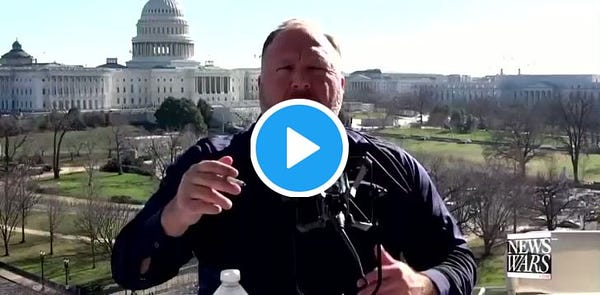
Per the above post-insurrection statement by Stop the Steal co-organizer Alex Jones,
The White House told me three days before [January 6], “We’re going to have you [Jones] lead the march. The Secret Service—before Trump finishes, thirty minutes before or so—will lead you to a point, take you out of the front row, and lead you to the place where they [the White House and the Secret Service] want you to start the march [on the Capitol]. And Trump will tell people [at the Ellipse], ‘Go, and I’m going to meet you at the Capitol.’”
Jones thereafter confirms that the plan ultimately proceeded as planned, with the surprising twist that the march to the Capitol had already started by the time the Secret Service led him to the event’s anticipated starting position.
Lest you think this claim to be one that Jones only made post-insurrection, perhaps after having some time to reflect on how he wanted to be perceived in the whole affair, that’s simply not so: Jones was quite clear, during the insurrection, as to what he believed Trump’s January 6 plan was. See the below video (permanently archived at Proof here):

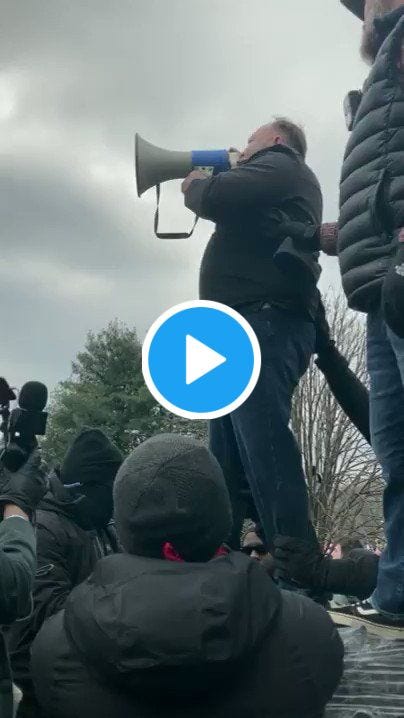
Nor is this the only such video of Jones using a bullhorn to announce, on January 6, that Trump would be appearing at the front of the Capitol on a stage Stop the Steal had constructed for the “Wild Protest” Trump had been advertising on Twitter since mid-December. The ProPublica video archive of the events of Insurrection Day has several more such videos. Moreover, Proof has a full article on Jason Rink, one of the men who helped set up Stop the Steal’s Capitol-steps stage as he was in the midst of filming a documentary about the co-organizers of the Stop the Steal movement.
And here’s where events get even muddier.
A Civil War Within the Stop the Steal Movement
According to Paul Escandon, the director of Jason Rink’s documentary about the Stop the Steal movement, White House agents either participated in an early-morning January 5 phone with Stop the Steal organizers or had already spoken to the Stop the Steal organizers in sufficient detail prior to January 5 that the organizers knew, by midday January 5, that Trump wouldn’t be speaking on the Capitol steps on January 6.
Whether one credits Escandon’s claims or not, they create a serious scandal inside not just the Stop the Steal movement but the United States Secret Service as well. What they suggest is that one of the three primary Stop the Steal organizers, Roger Stone, did not believe Trump’s January 6 declaration that he would be going to the Capitol on that day, and therefore stayed away from the Capitol entirely—even though he was scheduled to speak at the “Wild Protest”—while two other organizers, Ali Alexander and Jones, accepted Trump’s representation as accurate and consequently repeatedly told insurrectionists on January 6 that Trump would indeed be coming to the Capitol to speak at their previously announced event.
So why did Stone disbelieve Trump’s promise, whereas Jones and Alexander did not?
One possibility, of course, is that Trump directly informed Stone of his actual plan—to flee to the White House immediately following his speech at the Ellipse—either when Stone visited Trump in Mar-a-Lago in late December 2020, just nine days before the insurrection, or during one of the duo’s regular phone calls.
{Note: This would suggest that Trump already knew by late December, from either the Secret Service’s security assessment or from his adviser Stone, that events at the Capitol on January 6 would be dangerous—an awareness that would readily establish a criminal intent to incite for his deliberately explosive January 6 speech at the Ellipse.}
But a second possibility, indeed one that could comfortably sit beside the first, is that Jones was convinced of Trump’s intent to come to the Capitol not just by his contacts with the White House “three days before” January 6 (the timeline he establishes in the video linked to above) but also because of the actions of the Secret Service on January 6.
As Proof has previously reported via photographic evidence supplied by Trump donor (and January 5 “war council” attendee) Daniel Beck on social media, Alex Jones was indeed sitting in the VIP section of Trump’s Ellipse speech, as he claimed; had indeed funded the the logistics of that speech with Trump mega-donor Julie Jenkins Fancelli, as he’d claimed; and his organization had indeed been in contact with White House officials as he (and his co-organizer Ali Alexander) had repeatedly publicly claimed. So there is considerably more evidence that Trump had told at least two of the Stop the Steal organizers, during the period of his back-and-forth with the Secret Service, that he would in fact be going to the Capitol steps after he spoke at the Ellipse, than there is evidence that Trump never had such a plan, let alone that he never had such a plan and never communicated it to anyone (or a third possibility, namely that he never had or communicated such a plan to anyone until, as Paul Escandon avers, he suddenly and recklessly announced it at his January 6 Ellipse speech).
The Oath Keepers and the Secret Service
But perhaps the most damning corroboration of Jones’s claims comes not from anyone inside the Stop the Steal movement, but someone who was a key part of a very different insurrectionist organization: the Oath Keepers militia.
As Jim Sciutto of CNN reported on February 21, not just a run-of-the-mill member of the Oath Keepers—a group now known to have coordinated the assault on the Capitol with the Proud Boys—but indeed a “leader in [the] alleged Oath Keepers conspiracy in [the] Capitol insurrection” has made a claim that echoes Alex Jones’s near-perfectly, not just with respect to involvement in the insurrection by the Secret Service broadly writ but the location, nature, and purpose of the strategic assistance offered to the insurrectionists—on and before January 6—by the taxpayer-funded government entity.
Jessica Watkins, now one of the most infamous insurrectionists in America, insists she “met with Secret Service agents” after receiving (like Jones) a “VIP pass to [the] Trump rally [at the Ellipse on] January 6.”
{Note: Per the Wall Street Journal, The Oath Keepers plot since revealed by federal charging documents involved 30 to 40 Oath Keepers corralling the members of the U.S. Congress into the tunnels under the Capitol and then “gassing” them. The possibility that the Secret Service facilitated the logistics of a plot to murder the entirety of Congress, yet has not had a thorough house-cleaning since this scheme was executed less than 90 days ago, may be the most stunning revelation in the Secret Service’s history. See more on this in the “Conclusion” section, below.}

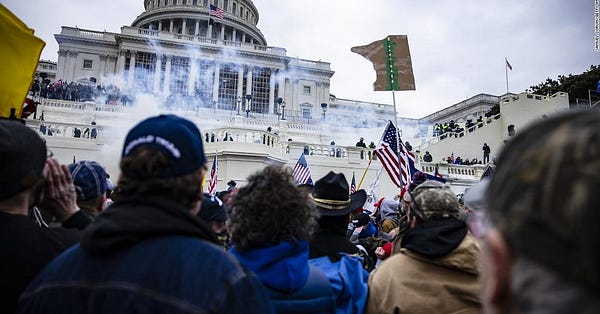
Needless to say, it wasn’t the U.S. Secret Service that was deciding who would get VIP passes to Trump’s January 6 Ellipse speech. Rather, it was the Trump White House—quite likely (though this last piece of the narrative remains unconfirmed) the former Secret Service detail head who was then White House Chief of Operations: Anthony Ornato.
Indeed, Ornato’s history of organizing Trump events, and his apparent continued direction of Secret Service activities following his move to Trump’s political team, makes him not just a probable but perhaps the only White House official in a position to both determine who would have VIP access to a presidential event and coordinate Secret Service agents making contact with, and discussing logistics with, civilians (a course of conduct one can only think is so far outside Secret Service security protocols as to be without precedent in the history of the Service).
As importantly, Jessica Watkins’ alleged awareness of the Secret Service’s plans for the January 6 march gives Roger Stone yet another means of determining what he did or did not believe (or should or should not believe) about Trump’s plans for January 6. As Proof has covered in too many articles on Stone to link to—just see the Proof archive—Stone was being guarded by the Oath Keepers on January 5, including some who later stormed the Capitol, and has longstanding contacts with the pro-Trump organization they are now known to have conspired with prior to the insurrection, the Proud Boys.
{Note: The Daily Beast has gone so far as to term the Proud Boys Stone’s “personal army.”}
Conclusion
The most obvious domino that needs to fall, in light of this brewing scandal within the Secret Service, is that—in the event it hasn’t happened already and simply been hidden from the American people—the Secret Service needs to conduct a thorough internal review to determine which agents met with Jones, Watkins, and any other civilians to coordinate logistics on January 6. One imagines that either no such review has yet occurred, no such review has yet been completed, or no such review has been leaked to the media in the way the December 2020 Ornato review was, as we have heard nothing about further wholesale post-inauguration changes at the Secret Service in the manner we have heard of the U.S. Capitol Police suspending six officers and investigating 29 others for their possible complicity in certain of the events of January 6 and did hear about the move involving Ornato from the Washington Post in late December of 2020.
To be clear, I do not submit, here, that there is any reason to believe President Biden is unsafe, merely that (1) Trump has proven himself to be an unapologetic domestic terror leader who continues to—up to this very day, in calls to Fox News—spread the “Big Lie” he by now is more than aware has launched a nationwide insurrection, and (2) reassigning Ornato to a training facility and adding known Biden loyalists to the president’s Secret Service detail does not resolve the apparent certainty that a number of its agents broke protocol to conspire with insurrectionists on and before January 6.
This is not an academic or merely administrative matter. Donald Trump’s increasingly obvious pre-insurrection conspiracy of silence about his actual plans for January 6 (a conspiracy we now know the Secret Service was at the heart of, per Reuters) appears to have been the proximate cause of many insurrectionists believing Donald Trump was physically with them during their attack on the Capitol—which misapprehension was aided not just by Alex Jones and his Stop the Steal compatriots, but the apprehensions that Jones had, and perhaps even key Oath Keepers and Proud Boys had, because of the former’s contact with the Secret Service. How can it be anything like acceptable if even one such insurrectionist remains on Biden’s protective detail, or indeed in the Secret Service at any level? While such an individual wouldn’t necessarily be a direct physical danger to the president, Secret Service protocols would very likely treat them as such.
The greater danger, of course, is that such a person might continue to feed intelligence to Donald Trump’s allies or agents in precisely the same fashion they did on January 6.
Thus far we’ve heard nothing from Congress on this; nothing from the White House on this, and nothing from major media on this. It is presumed, incredibly, that Ornato was the sole bad apple in Trump’s Secret Service, so much so that even his second-in-command is apparently thought to have had so little idea what his superior was doing that he deserved to be promoted by Biden in December and have his promotion maintained.
It is almost unthinkable that Biden’s political team should already have concluded by December 2020—note, prior to Inauguration Day and prior to Insurrection Day, when its ability to conduct a full investigation was zero, and its basis for such investigation hadn’t yet arisen—that Ornato was a “lone wolf” bad actor whose reassignment would end any inquiry into the possibility of a seditious conspiracy inside the Secret Service.
And we must be clear on the fact that this is what Alex Jones and Jessica Watkins—notably, two pro-Trump activists—describe: a conspiracy involving Trump’s political team and agents within the Secret Service to deliberately create confusion and a conspiracy of silence around Trump’s January 6 plans, to facilitate the march on the Capitol, and to maintain a conspiracy of silence around these clandestine activities even after it was clear that (a) Trump’s lies about his plans had fomented an armed rebellion, and (b) individuals with whom the Secret Service had broken protocol to coordinate with turned out to be (per DOJ prosecutors) not just insurrectionists but insurrectionist leaders.
Despite all this, a Google News search for Anthony Ornato’s name conducted on March 24, 2021 reveals zero English-language news articles about the man in the last month. Expanding the search to include all articles since January 6 returns just one English-language article, from Bloomberg, which only notes that “Trump’s outgoing deputy chiefs of staff, Tony Ornato and Chris Liddell, the transition director, were among a skeleton crew who remained in the final hours of Trump’s administration.”
{Note: If indeed it turns out that Ornato was involved in nefarious activity with respect to the insurrection, even this squib takes on an ominous cast—as it suggests that an individual with a motive to destroy evidence of certain pre- and post-insurrection White House communications was one of the last to leave the White House in the four years of the Trump administration.}
These deeply troubling revelations indicate that, for all the recent focus by Congress on the actions of the House and Senate sergeants-at-arms, the U.S. Capitol Police, the D.C. Metropolitan Police, and officials (including Trump stooges Kash Patel and Ezra Cohen-Watnick and would-be Trump-appointed Defense Policy Board member Corey Lewandowski) at and around the Pentagon, the real action in any investigation of an “inside job” related to the executive branch of the U.S. government must focus, first and foremost, on the U.S. Secret Service—a group whose agents were closer than any other to then-President Trump when he launched an armed rebellion against America.





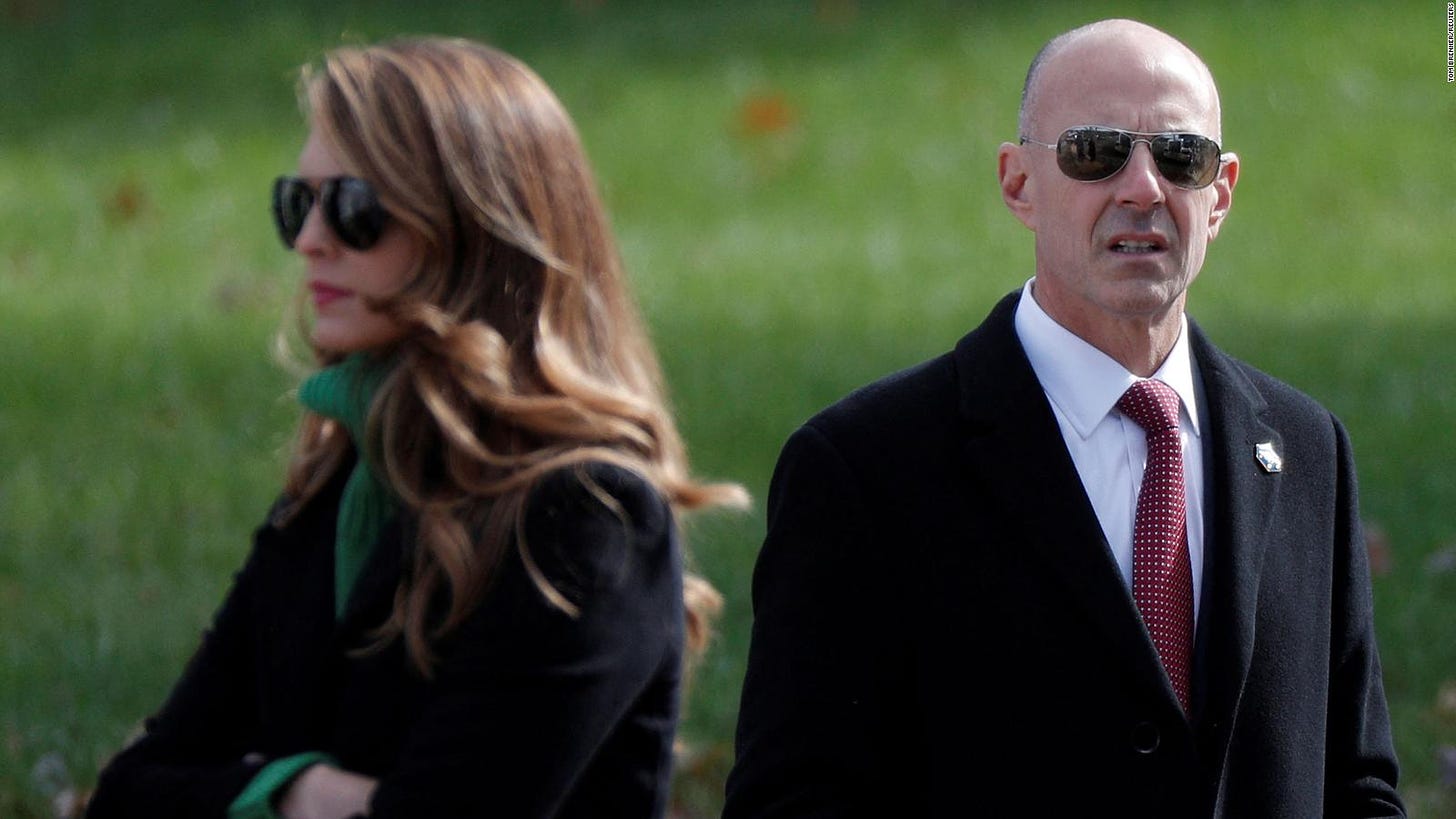






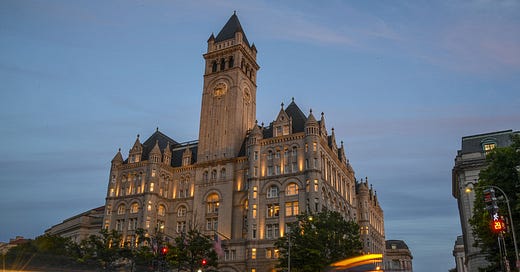

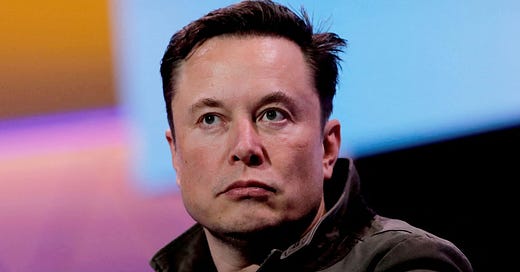



I always thought it telling Trump wasn’t locked down with the Congress under attack. That is SOP and stinks to high heaven he was roaming around sharing his enthusiasm for what he was seeing...people “standing up for him."
As scary as this reads, I still have to thank you Seth for getting all of this information together. There would be far less legitimate discourse about this criminal enterprise without you connecting the dots.